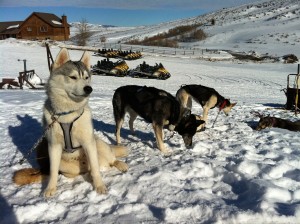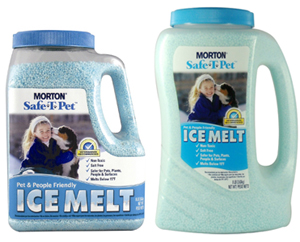 This article appeared as a guest post on the Embrace Pet Insurance Blog.
Seasonal changes create altered patterns of daylight, temperature, and humidity. Besides cold and snow, winter is especially dangerous for pets due to the repeated dispersing of toxins serving to facilitate human acclimation to averse weather.
How can your pets thrive this winter despite all of mother nature and man’s contributions to the seemingly continuous seasonal assault? As a responsible caretaker, you must educate yourself on winter hazards and proactively protect your pet in every conceivable situation.
Cold
Outdoor dogsThe transition from fall into winter brings darker days and chilly temperatures capable of adversely affecting your pet’s external and internal body systems. Exposure to cold can cause hypothermia or frostbite, both of which require immediate veterinary care.
Hypothermia occurs when your pet’s body temperature reduces precipitously below normal (higher than that of humans, ranging from 100-102.5 +/- 0.5). Core temperature reduction associated with hypothermia causes decreased blood perfusion to the extremities (feet, ears, etc) to maintain sufficient supply to the vital organs (heart, lungs, brain, kidneys, liver). Insufficient blood flow to the extremities slows down a pet’s mobility, reduces tissue oxygenation, and makes body parts cold to the touch and appear pale pink to blue.
Frostbite occurs when the periphery suffers prolonged exposure to extreme temperatures. Body tissues begin to decompose and become gangrenous, which is painful and requires extensive (and costly) medical treatments.
Exposure to moisture increases your pet’s heat loss and contributes to hypothermia and frostbite. When rain, sleet, snow, and ice contact the skin, heat more easily escapes the body. A healthy pelt of hair or a coat of water resistant material can repeal some of nature’s assault, but only for a limited time.
A pet should never be kept exclusively outdoors in a cold environment. Always provide a thermoregulated shelter in your house, garage, or outdoors with comfortable bedding and a fresh water station. Water freezes when temperatures drop below 32 F, so ensure that a bowl shaped ice cube doesn’t become your pet’s only available hydration source.
Heat
When outdoor temperatures drops, on goes the indoor heat. Unfortunately, most heating systems carry potential health hazards for your pet.
This article appeared as a guest post on the Embrace Pet Insurance Blog.
Seasonal changes create altered patterns of daylight, temperature, and humidity. Besides cold and snow, winter is especially dangerous for pets due to the repeated dispersing of toxins serving to facilitate human acclimation to averse weather.
How can your pets thrive this winter despite all of mother nature and man’s contributions to the seemingly continuous seasonal assault? As a responsible caretaker, you must educate yourself on winter hazards and proactively protect your pet in every conceivable situation.
Cold
Outdoor dogsThe transition from fall into winter brings darker days and chilly temperatures capable of adversely affecting your pet’s external and internal body systems. Exposure to cold can cause hypothermia or frostbite, both of which require immediate veterinary care.
Hypothermia occurs when your pet’s body temperature reduces precipitously below normal (higher than that of humans, ranging from 100-102.5 +/- 0.5). Core temperature reduction associated with hypothermia causes decreased blood perfusion to the extremities (feet, ears, etc) to maintain sufficient supply to the vital organs (heart, lungs, brain, kidneys, liver). Insufficient blood flow to the extremities slows down a pet’s mobility, reduces tissue oxygenation, and makes body parts cold to the touch and appear pale pink to blue.
Frostbite occurs when the periphery suffers prolonged exposure to extreme temperatures. Body tissues begin to decompose and become gangrenous, which is painful and requires extensive (and costly) medical treatments.
Exposure to moisture increases your pet’s heat loss and contributes to hypothermia and frostbite. When rain, sleet, snow, and ice contact the skin, heat more easily escapes the body. A healthy pelt of hair or a coat of water resistant material can repeal some of nature’s assault, but only for a limited time.
A pet should never be kept exclusively outdoors in a cold environment. Always provide a thermoregulated shelter in your house, garage, or outdoors with comfortable bedding and a fresh water station. Water freezes when temperatures drop below 32 F, so ensure that a bowl shaped ice cube doesn’t become your pet’s only available hydration source.
Heat
When outdoor temperatures drops, on goes the indoor heat. Unfortunately, most heating systems carry potential health hazards for your pet.
 Vents, electric blankets, and fireside snoozing spots all can cause thermal skin burns. Never permit your pet to come into close or prolonged contact with such seemingly cozy thermoregulatory sources. Kerosene and other fuels emit toxic vapors and create safety hazards for pets and people alike. Avoid using these fuel-based sources to warm your home environment.
Ventilation units can harbor dangerous bacteria, mold, and other toxins that aerosolize upon activation. These are inhaled by your pet and cause respiratory, liver, and other organ system damage. Make sure to perform maintenance and clean filters as recommended by manufacturers guidelines.
Juvenile, geriatric, and sick animals are more prone to the detriments of cold and heat than your average, healthy adult. Pets at the extremes of age and wellness are less able to remove themselves from harsh environments and less efficiently acclimate to environmental changes. Make sure give extra attention to the needs of youngsters, seniors, and ailing pets during wintry months.
Salt
Winter’s chill also creates hazardous transportation conditions caused by accumulation of ice, sleet, and snow. To manage our treacherous drives and walks, humans commonly turn to rock salt, which is toxic to your pets’ exterior and interior.
Vents, electric blankets, and fireside snoozing spots all can cause thermal skin burns. Never permit your pet to come into close or prolonged contact with such seemingly cozy thermoregulatory sources. Kerosene and other fuels emit toxic vapors and create safety hazards for pets and people alike. Avoid using these fuel-based sources to warm your home environment.
Ventilation units can harbor dangerous bacteria, mold, and other toxins that aerosolize upon activation. These are inhaled by your pet and cause respiratory, liver, and other organ system damage. Make sure to perform maintenance and clean filters as recommended by manufacturers guidelines.
Juvenile, geriatric, and sick animals are more prone to the detriments of cold and heat than your average, healthy adult. Pets at the extremes of age and wellness are less able to remove themselves from harsh environments and less efficiently acclimate to environmental changes. Make sure give extra attention to the needs of youngsters, seniors, and ailing pets during wintry months.
Salt
Winter’s chill also creates hazardous transportation conditions caused by accumulation of ice, sleet, and snow. To manage our treacherous drives and walks, humans commonly turn to rock salt, which is toxic to your pets’ exterior and interior.
 Drying or irritation occurs when salt contacts the skin’s surface. Prolonged or frequent exposure increases the likelihood of tissue damage. Salt ingestion contributes to a variety of gastrointestinal problems, including vomiting, diarrhea, and inappetence. Life threatening metabolic and cardiovascular imbalances occur as a result of electrolyte abnormalities associated with salt consumption.
Avoid bringing your dog to salt seeded settings. Around your home, use sand or products that are labeled as safe for pets (Morton Safe-T-Pet, other) instead of salt.
Drying or irritation occurs when salt contacts the skin’s surface. Prolonged or frequent exposure increases the likelihood of tissue damage. Salt ingestion contributes to a variety of gastrointestinal problems, including vomiting, diarrhea, and inappetence. Life threatening metabolic and cardiovascular imbalances occur as a result of electrolyte abnormalities associated with salt consumption.
Avoid bringing your dog to salt seeded settings. Around your home, use sand or products that are labeled as safe for pets (Morton Safe-T-Pet, other) instead of salt. Help me win $500 (half of which I will be donating to pet cancer research) by "liking" Morton Safe-T-Pet on Facebook. Additionally, for every "like" Morton Safe T Paw gets, the ASPCA will receive a $1 donation. A simple click can really help pets in need.
Antifreeze (Ethylene Glycol)
This tasty danger is actually a year round pet threat. In preparation for cold weather, anti-freeze is often changed or refreshed in an automobile. Ethylene Glycol is the active ingredient in anti-freeze and only a small amount must be consumed to cause life threatening kidney failure.
Any spillage in a location accessible to your pet could attract an exploring tongue for a sample of the sweet tasting substance. Keep up with regular vehicular maintenance to prevent leakage of anti-freeze and other toxic substances (oil, engine fluids, etc).
Have your car serviced by a licensed professional in a location away from your home. Forego conventional antifreeze for pet safe products (Sierra, other).
Even if you take steps to pet proof your outdoor environment from the dangers of ethylene glycol, a visitor’s car could leave behind an unwelcome green dribble on your driveway. Additionally, a casual stroll through a parking lot may harbor liquid catastrophe. Always walk your pet on a leash under close supervision of a responsible individual during wintery outings to restrict access to ingestible toxins.
Prevention is best means of keeping your pet from suffering the effects of topical or oral toxin exposure. Dedicate yourself to pet safety this winter and during all seasons. A single seemingly minor oversight could lead to otherwise preventable life threatening illness or injury.
Thank you for reading my article. To receive my next article via email, sign up by following this link.
Please feel free to communicate with me through Twitter (@PatrickMahaney) and follow my adventures in veterinary medicine by friending Patrick Mahaney: Veterinarian Acupuncture Pain Management for Your Pets on Facebook.
Copyright of this article (2011) is owned by Dr. Patrick Mahaney, Veterinarian and Certified Veterinary Acupuncturist. Republishing any portion of this article must first be authorized by Dr. Patrick Mahaney. Requests for republishing must be approved by Dr. Patrick Mahaney and received in written format.
Help me win $500 (half of which I will be donating to pet cancer research) by "liking" Morton Safe-T-Pet on Facebook. Additionally, for every "like" Morton Safe T Paw gets, the ASPCA will receive a $1 donation. A simple click can really help pets in need.
Antifreeze (Ethylene Glycol)
This tasty danger is actually a year round pet threat. In preparation for cold weather, anti-freeze is often changed or refreshed in an automobile. Ethylene Glycol is the active ingredient in anti-freeze and only a small amount must be consumed to cause life threatening kidney failure.
Any spillage in a location accessible to your pet could attract an exploring tongue for a sample of the sweet tasting substance. Keep up with regular vehicular maintenance to prevent leakage of anti-freeze and other toxic substances (oil, engine fluids, etc).
Have your car serviced by a licensed professional in a location away from your home. Forego conventional antifreeze for pet safe products (Sierra, other).
Even if you take steps to pet proof your outdoor environment from the dangers of ethylene glycol, a visitor’s car could leave behind an unwelcome green dribble on your driveway. Additionally, a casual stroll through a parking lot may harbor liquid catastrophe. Always walk your pet on a leash under close supervision of a responsible individual during wintery outings to restrict access to ingestible toxins.
Prevention is best means of keeping your pet from suffering the effects of topical or oral toxin exposure. Dedicate yourself to pet safety this winter and during all seasons. A single seemingly minor oversight could lead to otherwise preventable life threatening illness or injury.
Thank you for reading my article. To receive my next article via email, sign up by following this link.
Please feel free to communicate with me through Twitter (@PatrickMahaney) and follow my adventures in veterinary medicine by friending Patrick Mahaney: Veterinarian Acupuncture Pain Management for Your Pets on Facebook.
Copyright of this article (2011) is owned by Dr. Patrick Mahaney, Veterinarian and Certified Veterinary Acupuncturist. Republishing any portion of this article must first be authorized by Dr. Patrick Mahaney. Requests for republishing must be approved by Dr. Patrick Mahaney and received in written format.